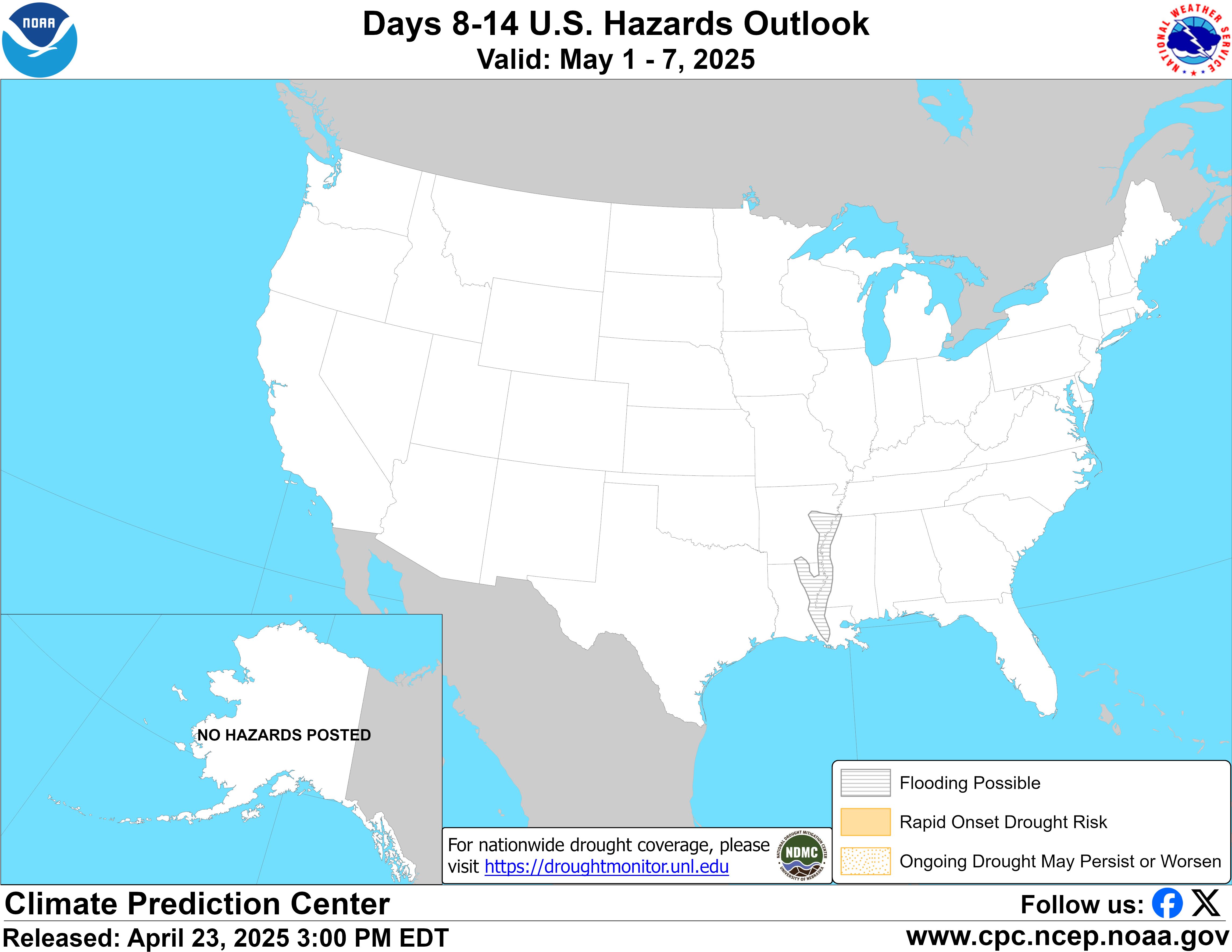HOME> Expert Assessments>Hazards Outlook
For 3-7 day hazards see Weather Prediction Center's: WPC 3-7 Day Hazards
U.S. Week-2 Hazards Outlook - Made April 30, 2025 | About the Hazards Outlook
ATTENTION:
We would like to hear from you! Please provide your feedback and suggestions about these outlooks by taking the customer satisfaction survey HERE.
Valid Thursday May 08, 2025 to Wednesday May 14, 2025
US Hazards OutlookNWS Climate Prediction Center College Park MD
300 PM EDT April 30 2025
Synopsis: Amplified mid-level low pressure is predicted to be centered over the Four Corners region during the end of week-1 which is anticipated to significantly weaken by the start of week-2. There may be some lingering precipitation and isolated thunderstorms in the south-central Contiguous U.S. (CONUS) at the beginning of week-2, although rainfall totals are not anticipated to reach hazardous criteria. Chances for associated widespread flooding is also anticipated to decrease, thus no flood hazards are designated today. A fairly weak mid-level pattern is expected to result in a fairly tranquil period with respect to the potential for hazards.
Hazards
For Saturday May 03 - Wednesday May 07: WPC Days 3-7 U.S. Hazards
For Thursday May 08 - Wednesday May 14: Multiple model ensemble means depict significant weakening of mid-level troughing over the Four Corners region at the end of week-1 by the beginning of week-2. This translates to decreasing signals of heavy precipitation in much of the model guidance and associated tools. The 0Z ECENS mean continues to favor a more amplified trough across the south-central CONUS, whereas the GEFS and CMCE depict a much weaker feature. The ECENS solution would be more favorable for lingering precipitation across parts of the Central and Southern Plains, primarily on day 8 (May 8). Due to the ECENS daily ensemble mean and uncalibrated probabilities indicating daily totals not likely to exceed half an inch of rainfall, no heavy precipitation hazards are designated for today. Additionally, the possible flood hazard is also removed in today’s outlook given decreasing chances for enhanced precipitation. Isolated thunderstorms, however, remain a possibility in this region that could lead to localized flash flooding. A stationary front may set up across the Central and Southern High Plains early in week-2 that may support isolated thunderstorms across the region. Widespread rainfall totals do not reach hazards criteria for this area either.
A transition to broad ridging is predicted across the CONUS during week-2, resulting in a fairly tranquil weather pattern, resulting in no hazards being designated. There continues to be a multi-model depiction of positive anomalous mid-level heights across the Upper Midwest at the beginning of the period. The Probabilistic Extremes Tools (PETs) show at least a 20% chance of maximum temperatures exceeding the 90th percentile in this region, although temperatures are not anticipated to exceed 90 deg F, thus no associated excessive heat hazard is designated.
Weak troughing is predicted across much of Alaska, with near normal to slightly below 500 hPa height departures favoring a fairly quiet weather pattern for much of the state. No hazards are designated for Alaska.
Forecaster: Melissa Ou
$$ Please consult local NWS Forecast Offices for short range forecasts and region-specific information.
Resources
Week-2 Probabilistic Extremes Tool
GFS Ensemble Forecasts
